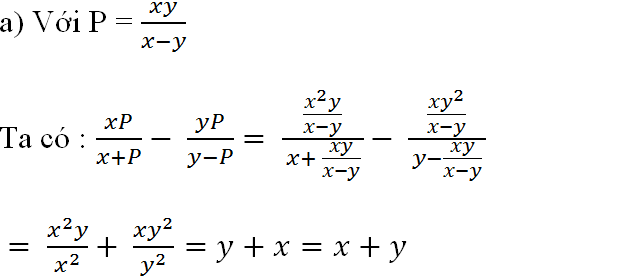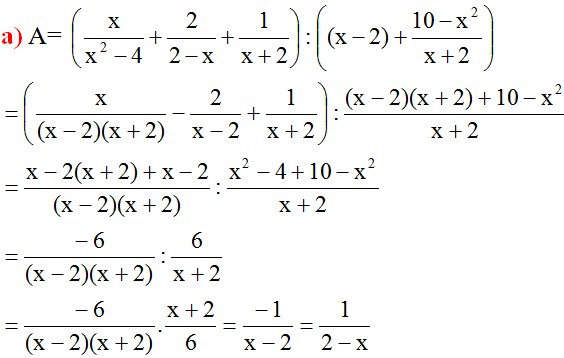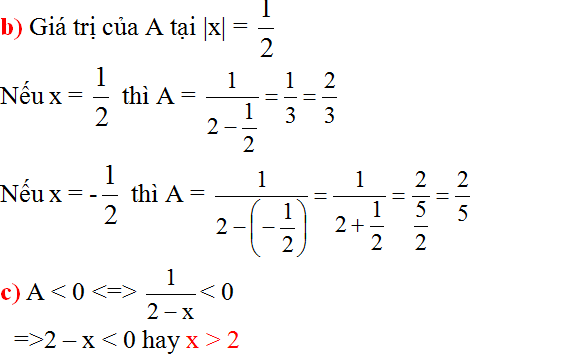Hãy nhập câu hỏi của bạn vào đây, nếu là tài khoản VIP, bạn sẽ được ưu tiên trả lời.

x2−10x=x(x−10)≠0x2−10x=x(x−10)≠0 khi x≠0;x−10≠0x≠0;x−10≠0
Hay x≠0;x≠10x≠0;x≠10
x2+10x=x(x+10)≠0x2+10x=x(x+10)≠0 khi x≠0;x+10≠0x≠0;x+10≠0
Hay x≠0;x≠−10x≠0;x≠−10
x2+4≥4x2+4≥4
Vậy điều kiện của biến x để biểu thức đã cho được xác định là
x≠−10,x≠0,x≠10x≠−10,x≠0,x≠10
Để việc tính giá trị của biểu thức được đơn giản hơn ta rút gọn biểu thức trước :
(5x+2x2−10x+5x−2x2+10x).x2−100x2+4(5x+2x2−10x+5x−2x2+10x).x2−100x2+4
= [
ĐKXĐ: x2 - 10x khác 0, x2 + 10x khác 0
<=> x khác 0 và x khác +-10.
\((\dfrac{5x + 2}{x^2-10x}+\dfrac{5x-2}{x^2+10x}).\dfrac{x^2-100}{x^2+4}\)
= \(\dfrac{(5x+2)(x+10)+(5x-2)(x-10)}{x(x-10)(x+10)} .\dfrac{(x-10)(x+10)}{x^2+4}\)
= \(\dfrac{5x^2+12x+20+5x^2-12x+20}{x(x^2+4)}\)
= \(\dfrac{10x^2+40}{x(x^2+4)}\)
= \(\dfrac{10(x^2-4)}{x(x^2-4)}\)
= \(\dfrac{10}{x}\)
Thay x = 20040 vào biểu thức, ta có:
\(\dfrac{10}{20040}\) = \(\dfrac{1}{2004}\)

điều kiện của x để gtrị của biểu thức đc xác định
=>\(2x+10\ne0;x\ne0:2x\left(x+5\right)\ne0\)
\(2x+5\ne0;x\ne0\)
=>\(x\ne-5;x\ne0\)
vậy đkxđ là \(x\ne-5;x\ne0\)
rút gon giống với bạn nguyen thuy hoa đến \(\dfrac{x-1}{2}\)
b,để bt =1=>\(\dfrac{x-1}{2}=1\)
=>x-1=2
=>x=3 thỏa mãn đkxđ
c,d giống như trên

Lời giải của bạn Nhật Linh đúng rồi, tuy nhiên cần thêm điều kiện để A có nghĩa: \(x\ne\pm2\)

a)
\(\left\{{}\begin{matrix}x-1\ne0\\x+2\ne0\end{matrix}\right.\)
b)
x khác 1
c)
x khác 0; x khác 5
d) x khác 5 ; x khác -5

Bài 1:
a) x≠2x≠2
Bài 2:
a) x≠0;x≠5x≠0;x≠5
b) x2−10x+25x2−5x=(x−5)2x(x−5)=x−5xx2−10x+25x2−5x=(x−5)2x(x−5)=x−5x
c) Để phân thức có giá trị nguyên thì x−5xx−5x phải có giá trị nguyên.
=> x=−5x=−5
Bài 3:
a) (x+12x−2+3x2−1−x+32x+2)⋅(4x2−45)(x+12x−2+3x2−1−x+32x+2)⋅(4x2−45)
=(x+12(x−1)+3(x−1)(x+1)−x+32(x+1))⋅2(2x2−2)5=(x+12(x−1)+3(x−1)(x+1)−x+32(x+1))⋅2(2x2−2)5
=(x+1)2+6−(x−1)(x+3)2(x−1)(x+1)⋅2⋅2(x2−1)5=(x+1)2+6−(x−1)(x+3)2(x−1)(x+1)⋅2⋅2(x2−1)5
=(x+1)2+6−(x2+3x−x−3)(x−1)(x+1)⋅2(x−1)(x+1)5=(x+1)2+6−(x2+3x−x−3)(x−1)(x+1)⋅2(x−1)(x+1)5
=[(x+1)2+6−(x2+2x−3)]⋅25=[(x+1)2+6−(x2+2x−3)]⋅25
=[(x+1)2+6−x2−2x+3]⋅25=[(x+1)2+6−x2−2x+3]⋅25
=[(x+1)2+9−x2−2x]⋅25=[(x+1)2+9−x2−2x]⋅25
=2(x+1)25+185−25x2−45x=2(x+1)25+185−25x2−45x
=2(x2+2x+1)5+185−25x2−45x=2(x2+2x+1)5+185−25x2−45x
=2x2+4x+25+185−25x2−45x=2x2+4x+25+185−25x2−45x
=2x2+4x+2+185−25x2−45x=2x2+4x+2+185−25x2−45x
=2x2+4x+205−25x2−45x=2x2+4x+205−25x2−45x
c) tự làm, đkxđ: x≠1;x≠−1

\(ĐKXĐ:x\ne-3;2\)
\(\frac{x+2}{x+3}-\frac{5}{x^2+x-6}-\frac{1}{x-2}=\frac{x+2}{x+3}-\frac{5}{\left(x+3\right)\left(x+2\right)}-\frac{1}{x-2}\)
\(=\frac{x^2+4x+4}{\left(x+3\right)\left(x+2\right)}-\frac{5}{\left(x+3\right)\left(x+2\right)}-\frac{x+3}{\left(x+2\right)\left(x+3\right)}\)
\(=\frac{x^2+4x+4-5-x-3}{\left(x+2\right)\left(x+3\right)}=\frac{x^2+3x-4}{\left(x+3\right)\left(x+2\right)}=\frac{\left(x+4\right)\left(x-1\right)}{\left(x+3\right)\left(x+2\right)}\)
\(x^2-9=0\Leftrightarrow x=3\left(vì:x\ne-3\right)\)
\(\Rightarrow P=\frac{7}{15}\)
\(P\inℤ\Leftrightarrow x^2+3x-4⋮x^2+5x+6\Leftrightarrow2x+10⋮x^2+5x+6\Leftrightarrow12⋮x^2+5xx+6\)
\(................\left(dễ\right)\)
P/s: shitbo sai rồi nha bạn!Nếu không tin thì thay x = 3 vào P ban đầu và giá trị P sau khi rút gọn sẽ thấy sự khác biệt =)
ĐK: \(x\ne-3;x\ne2\)
a) \(P=\frac{x+2}{x+3}-\frac{5}{x^2+x-6}-\frac{1}{x-2}\)
\(=\frac{x^2-4}{\left(x+3\right)\left(x-2\right)}-\frac{5}{\left(x-2\right)\left(x+3\right)}-\frac{x+3}{\left(x-2\right)\left(x+3\right)}\)
\(=\frac{x^2-x-12}{\left(x+3\right)\left(x-2\right)}=\frac{\left(x-4\right)\left(x+3\right)}{\left(x+3\right)\left(x-2\right)}=\frac{x-4}{x-2}\)
b) \(x^2-9=0\Leftrightarrow x^2=9\Leftrightarrow x=\pm3\)
Thay vào điều kiện,tìm loại x = -3 .Tìm được x =3
Ta có: \(P=\frac{x-4}{x-2}=\frac{3-4}{3-2}=-1\)
c)Ta có: \(P=\frac{x-4}{x-2}=\frac{x-2-2}{x-2}=1-\frac{2}{x-2}\)
Để P có giá trị nguyên thì \(\frac{2}{x-2}\) nguyên hay \(x-2\inƯ\left(2\right)=\left\{\pm1;\pm2\right\}\)
Suy ra \(x=\left\{0;1;3;4\right\}\)

a) P xác định \(\Leftrightarrow\hept{\begin{cases}2x+10\ne0\\x\ne0\\2x\left(x+5\right)\ne0\end{cases}\Leftrightarrow x\ne\left\{-5;0\right\}}\)
b) \(P=\frac{x^2+2x}{2x+10}+\frac{x-5}{x}+\frac{50-5x}{2x\left(x+5\right)}\)
\(P=\frac{x^2\left(x+2\right)}{2x\left(x+5\right)}+\frac{2\left(x-5\right)\left(x+5\right)}{2x\left(x+5\right)}+\frac{5\left(10-x\right)}{2x\left(x+5\right)}\)
\(P=\frac{x^3+2x^2+2x^2-50+50-5x}{2x\left(x+5\right)}\)
\(P=\frac{x^3+4x^2-5x}{2x\left(x+5\right)}\)
\(P=\frac{x^3+5x^2-x^2-5x}{2x\left(x+5\right)}\)
\(P=\frac{x^2\left(x+5\right)-x\left(x+5\right)}{2x\left(x+5\right)}\)
\(P=\frac{\left(x+5\right)\left(x^2-x\right)}{2x\left(x+5\right)}\)
\(P=\frac{x\left(x-1\right)}{2x}\)
\(P=\frac{x-1}{2}\)
c) Để P = 0 thì \(x-1=0\Leftrightarrow x=1\)( thỏa mãn ĐKXĐ )
Để P = 1/4 thì \(\frac{x-1}{2}=\frac{1}{4}\)
\(\Leftrightarrow4\left(x-1\right)=2\)
\(\Leftrightarrow4x-4=2\)
\(\Leftrightarrow4x=6\)
\(\Leftrightarrow x=\frac{3}{2}\)( thỏa mãn ĐKXĐ )
d) Để P > 0 thì \(\frac{x-1}{2}>0\)
Mà 2 > 0, do đó để P > 0 thì \(x-1>0\Leftrightarrow x>1\)
Để P < 0 thì \(\frac{x-1}{2}< 0\)
Mà 2 > 0, do đó để P < 0 thì \(x-1< 0\Leftrightarrow x< 1\)

a: ĐKXĐ: x<>3; x<>-3; \(x\ne-5\pm\sqrt{34}\)
b: \(=\dfrac{x^2+5x+6+5x-15}{\left(x-3\right)\left(x+3\right)}\cdot\dfrac{2x\left(x-3\right)\left(x+3\right)}{x^2+10x-9}\)
=2x
c: Khi x=1/2 thì A=2*1/2=1




Bài 1:
a, Ta có:
\(\dfrac{x.\dfrac{xy}{x-y}}{x+\dfrac{xy}{x-y}}-\dfrac{y.\dfrac{xy}{x-y}}{y-\dfrac{xy}{x-y}}\)
\(=\dfrac{\dfrac{x^2y}{x-y}}{x+\dfrac{xy}{x-y}}-\dfrac{\dfrac{xy^2}{x-y}}{y-\dfrac{xy}{x-y}}\)
\(=\dfrac{\left(\dfrac{x^2y}{x-y}\right)\left(y-\dfrac{xy}{x-y}\right)-\left(\dfrac{xy^2}{x-y}\right)\left(x+\dfrac{xy}{x-y}\right)}{\left(x+\dfrac{xy}{x-y}\right)\left(y-\dfrac{xy}{x-y}\right)}\)
\(=\dfrac{\dfrac{x^2y^2}{x-y}-\dfrac{x^3y^2}{\left(x-y\right)^2}-\dfrac{x^2y^2}{x-y}-\dfrac{x^2y^3}{\left(x-y\right)^2}}{xy-\dfrac{x^2y}{x-y}+\dfrac{xy^2}{x-y}-\dfrac{x^2y^2}{\left(x-y\right)^2}}\)
\(=\dfrac{-\left(\dfrac{x^3y^2+x^2y^3}{\left(x-y\right)^2}\right)}{xy-\left(\dfrac{x^2y-xy^2}{x-y}\right)-\dfrac{x^2y^2}{\left(x-y\right)^2}}\)
\(=-\dfrac{\dfrac{x^2y^2\left(x+y\right)}{\left(x-y\right)^2}}{xy-\left(\dfrac{xy\left(x-y\right)}{\left(x-y\right)}\right)-\dfrac{x^2y^2}{\left(x-y\right)^2}}\)
\(=\dfrac{\dfrac{x^2y^2\left(x+y\right)}{\left(x-y\right)^2}}{\dfrac{x^2y^2}{\left(x-y\right)^2}}=x+y\)
Chúc bạn học tốt!! Làm một câu mà toát cả mồ hôi!
ài 1 chia rthay vào rút gọn tự làm đê